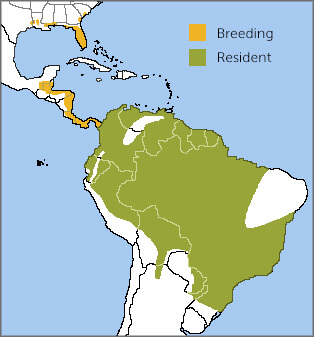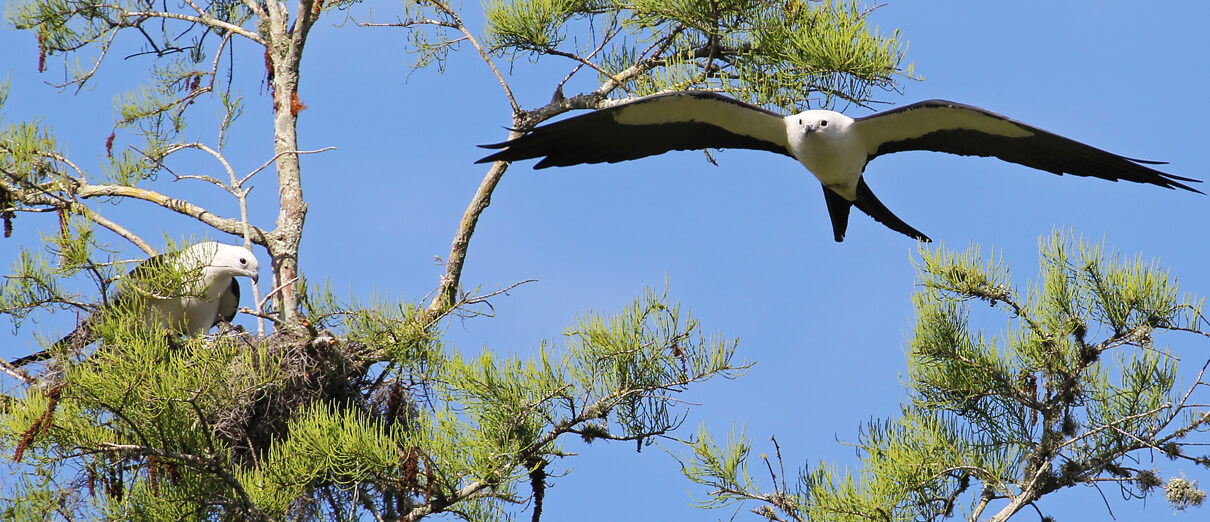
Range map by American BIrd Conservancy
The Swallow-tailed Kite is unmistakable in flight, with its long, pointed wings, deeply forked tail, and contrasting black-and-white plumage. This largest of American kites is a graceful, buoyant flier, so lightweight and maneuverable that it can capture a dragonfly mid-air or pluck a lizard from its treetop hideout — all without a single wing beat.
In flight, it frequently turns its tail, sometimes to nearly 90 degrees, using it as a rudder to maintain its flight path, veer sharply, or circle.
Kite Communities
Like the Harris's Hawk, the Swallow-tailed Kite is unusually gregarious for a raptor. Pairs commonly nest in close proximity, and outside the breeding season, communal night and pre-migratory roosts may attract hundreds of kites. These birds also migrate in large groups that sometimes number in the thousands.
Numerous Names
Easy to see overhead in areas where it nests, the Swallow-tailed Kite has gathered many names, including "Forked-tailed Kite" or "Swallow Hawk," nods to its unique appearance and flight style. In the 18th century, the English naturalist and illustrator Mark Catesby originally christened it Accipiter cauda furcata (forked-tail hawk). Other nicknames, such as "Wasp Hawk" or "Snake Hawk," describe the bird's diet of insects and small reptiles.
An American Kite
Two Swallow-tailed Kite subspecies are recognized. The population that nests in the United States breeds from coastal South Carolina to Florida and west to Louisiana and eastern Texas. These U.S. birds winter in South America. The other subspecies, comprising the majority of the world's Swallow-tailed Kites, is resident in Central and South America.
From its bill to the tips of its forked tail, the Swallow-tailed Kite measures almost two feet long, with a wingspan of over four feet. Its white body and black wings and distinctive tail make it easy to identify. This bird is usually seen in flight, often high over the trees, and is not often heard. One of its calls is a high-pitched, whistled klee-klee-klee.
(Audio: Swallow-tailed Kite flight call by Dusan M. Brinkhuizen, XC93821. Accessible at www.xeno-canto.org/93821.)
Life on the Wing
Swallow-tailed Kites primarily eat flying insects such as dragonflies and cicadas, which they capture and consume on the wing. But these predatory acrobats don't limit themselves to invertebrates: As they cruise the treetops, they also snag snakes, lizards, treefrogs, and even small bird nestlings and eggs. In South Florida, where Swallow-tailed Kites sometimes nest in suburbs, their diet includes hatchlings of the introduced and thriving Green Iguana. Unusual for raptors, Swallow-tailed Kites will eat fruit, especially on their wintering grounds. They even drink on the wing, skimming the water's surface to collect water, as do swallows.
During courtship, Swallow-tailed Kites spend a lot of time diving, chasing, and vocalizing. When ready to nest, they build a shallow cup of twigs, lined with Spanish moss or other soft vegetation. Pairs build their nests high in the crowns of tall trees such as pine, bald cypress, or cottonwood. In addition to towering trees, successful nesting requires nearby open areas where the birds find prey.
From hatching to fledging, young Swallow-tailed Kites spend up to six weeks in the nest. Not all reach maturity, however. As in other species ranging from the Great Egret to the Great Horned Owl, the first kite chick sometimes kills its younger, smaller sibling. Known as obligate siblicide, this seemingly cruel phenomenon reflects the breeding conditions of a particular year — if there is enough food, more chicks survive.

Nesting pair of Swallow-tailed Kites by Betty Rizzotti
A Shrunken Range
The Swallow-tailed Kite was once found all along the Mississippi River, as far north as Minnesota. Decades of widespread forest clearance and shooting took a heavy toll. The species once nested in 16 states but now breeds in only seven, with much of the population in Florida. Today, habitat loss remains the main threat to this species. In its U.S. range, large areas of humid bottomland forest have fallen to unsustainable logging and development. Although the U.S. population seems to be increasing due to reforestation in riparian areas, the trend may not last long, as these habitats are threatened anew by development.
ABC created a 50-50-5 Action Plan to stem bird population declines. The Swallow-tailed Kite is one of 50 flagship bird species identified in this plan, along with 50 priority ecosystems and five major threats.
In the southern United States, the Swallow-tailed Kite is once again becoming a familiar sight in some areas, thanks to coordinated efforts of many state, federal, and nongovernmental partners. The Avian Research and Conservation Institute (ARCI) has studied Swallow-tailed Kites for 25 years and developed science-based management recommendations. ARCI maintains a kite sighting database and monitors populations annually at large, pre-migration roosts numbering in the thousands in Florida before the birds fly south to Brazil and Bolivia for the winter. ABC works with ARCI and the Sustainable Forestry Initiative (SFI) to help guide forest management that benefits landowners while maintaining habitat for the Swallow-tailed Kite and other vulnerable species.
Pilot projects in development with the SFI aim to better understand, maintain, and potentially create desired habitat conditions for priority birds such as the Swallow-tailed Kite. In addition, ABC, ARCI, and International Paper have collaborated on management recommendations for the kite that help southeastern foresters incorporate the species' conservation into their forest management activities.
Donate to support ABC's conservation mission!



















































